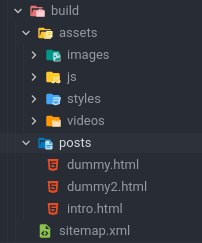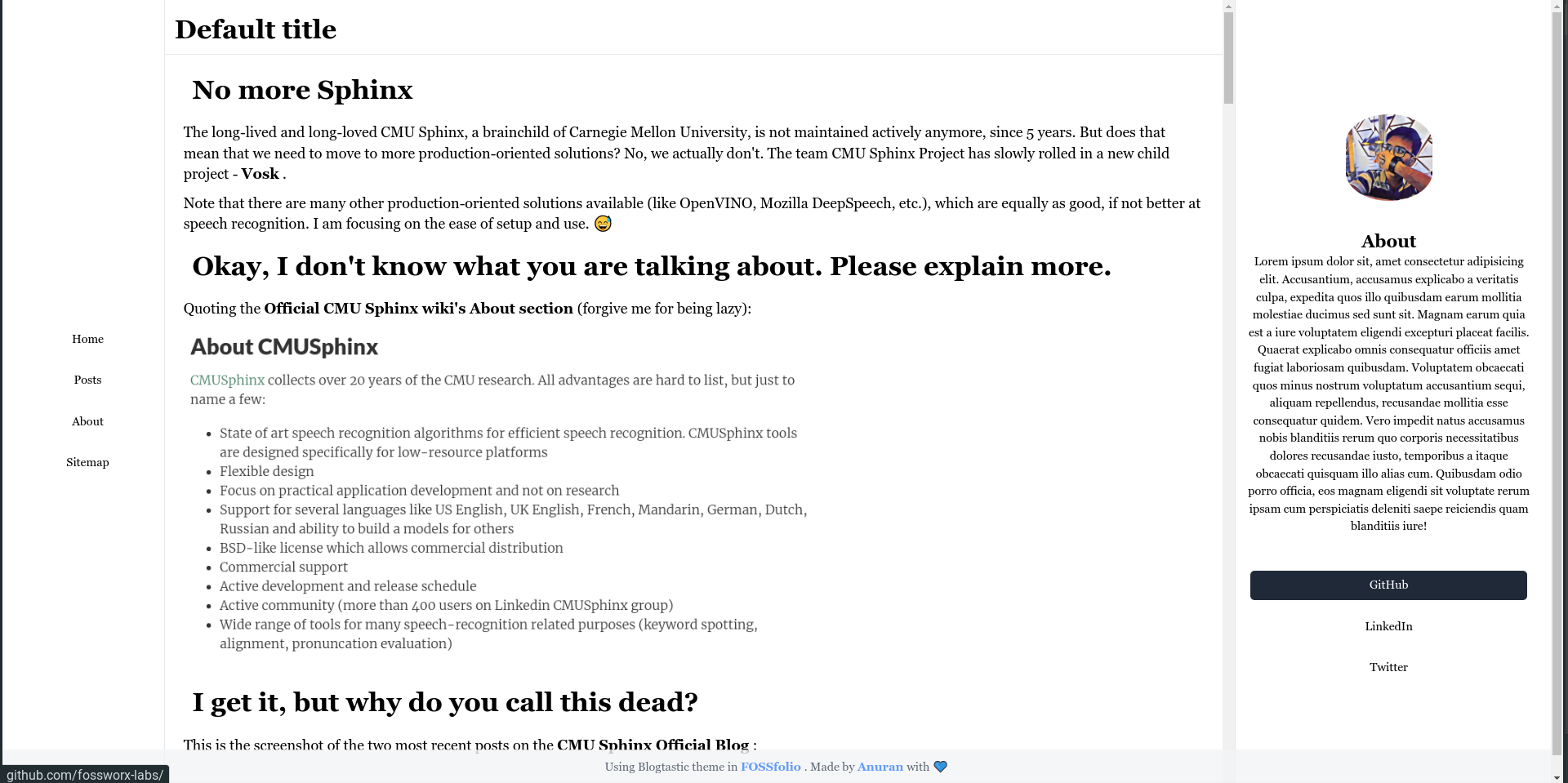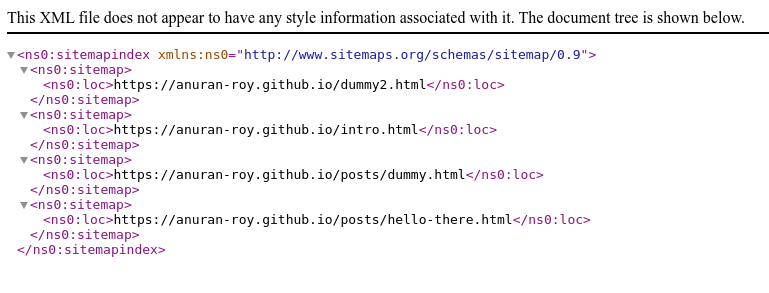https://github.com/fossworx-labs/fossfolio
A blazingly fast, fully hackable static site generator built on Python 3.9 with Markdown and templating support, with minimal dependencies
https://github.com/fossworx-labs/fossfolio
documentation-generator html low-code lowcode markdown md python3 static-site-generator staticsite staticsitegenerator website
Last synced: 2 months ago
JSON representation
A blazingly fast, fully hackable static site generator built on Python 3.9 with Markdown and templating support, with minimal dependencies
- Host: GitHub
- URL: https://github.com/fossworx-labs/fossfolio
- Owner: fossworx-labs
- License: mit
- Created: 2022-07-07T15:51:38.000Z (almost 3 years ago)
- Default Branch: main
- Last Pushed: 2023-07-20T11:39:29.000Z (almost 2 years ago)
- Last Synced: 2025-03-24T03:11:23.536Z (3 months ago)
- Topics: documentation-generator, html, low-code, lowcode, markdown, md, python3, static-site-generator, staticsite, staticsitegenerator, website
- Language: HTML
- Homepage: https://fossworx-labs.github.io/fossfolio/
- Size: 99.6 KB
- Stars: 29
- Watchers: 2
- Forks: 4
- Open Issues: 3
-
Metadata Files:
- Readme: README.md
- License: LICENSE.md
Awesome Lists containing this project
README
# FOSSFolio







Probably the simplest static site generator in the world! (Yes, inspired from Carlsberg commercials 😜)
## About FOSSFolio
FOSSFolio is a Free and Open Source Software (FOSS) meant for developers to create their own static websites (mostly portfolios), with fine-grained control.
## Intended Audience
Developers or coding enthusiasts who need a static site (maybe like a blog) with minimal effort.
## Features
* **Fully Hackable(!)**
* **Plugins to extend functionalities of basic templates:** A plugin can be anything- from replacing a simple placeholder with some simple value, to some complex JavaScript embedding beast, you can do anything with plugins, as long as you follow the rules for [Plugin Development](#plugin-development)
* **Jinja2 templating (under development):** You can use Jinja templating for all your themes, as well as create themes based on it!
* **Flexible page structure:** Whatever page structure you want, you can have it 😃, as long as you place it inside the `content/` folder, directly or indirectly. You just need to have a theme for it (or customize your theme accordingly).
* **Automatic sitemap generation on-the-fly**: Yes, I know that getting the SEO right is a pain. So I implemented an automated sitemap generator, which generates readable sitemaps (to the best of my knowledge) that can be easily crawled by Search Engine Bots 🥳.
## Screenshots
**Console while building a demo site:**


**Post rendered with default theme using the `default.html` mapping:**

**Post rendered with blogtastic theme using the `default.html` mapping:**

**Example of an auto-generated sitemap**:

## Getting started
The main objective of creating FOSSFolio was to avoid the different complexities imposed by other static site generator (like Hugo) that give you a lot of control, but have quite a learning curve. I really love Hugo, but sometimes it requires a lot of changes even to add/change some basic functionalities.
1. Clone this repository
2. Open the folder.
3. Install poetry using `pip install --upgrade poetry`.
4. Initialize poetry with `poetry init`
5. Install dependencies with `poetry install`
6. Navigate to `fossfolio` folder
7. Clear all the files and subfolders in the `assets` and `posts` folder
8. Put your own content in place of those
9. Run `python build.py`
10. The `build` folder will contain the generated static site.
## Templating with FOSSFolio
There are two kinds of syntaxes for templating with FOSSFolio:
* Plugin templates
* Jinja templates (coming soon)
### Plugin Templates
Plugins are the ad-hoc extensions in FOSSFolio. Plugin templates and their syntax are decided by the devs who write them - You have full control here!
#### Default Plugins:
I've given two default plugins for now:
* The `date_time` plugin: Inserts the current date-time wherever you insert `<% current_time %>` in your markdown files (Inspired from EJS syntax 😃)
* The `user_metadata` plugin: Inserts your PC's hostname wherever you insert `<% user %>` in your markdown files.
### Jinja templates *(Under development)*
You can use Jinja templates too. The context passing mechanism is under development.
## Hacking around
Keeping the intended audience in mind, the USP of FOSSFolio is the degree of customization it offers. You can hack about just anything - the templates, the plugins - heck even the `build.py` is a small file that aggregates all the small modules into a default workflow - you can hack around that as well.
You can even integrate the modules and functionalities into other larger programs!
Plugin Development
A plugin can consist of anything, as long as it satisfies the following criteria:
1. It has to act like a module (that is, it should have an `__init__.py`)
2. It should have a `main.py` file that acts like a controller for other functionalities of the plugin.
3. It should have a `run` method inside `main.py`, that will act as the controller method
4. The `run` method should return a dictionary containing the field `content` which will contain the modified html code. (Be very careful at this step, since it may open your plugin to JS-based vulnerabilities. Any sanity checks are your responsibility - in exchange for maximum freedom with what you can do.)
5. Your plugin should support pipelining (i.e., stacking plugins on top of another, getting the final output after passing through functions sequentially).
**Some points you may want to keep in mind:**
1. Plugins are processed before wrapping the html code in the template. So you should be careful not to change any placeholder for Jinja while processing.
2. Not a strict rule, but `<%...%>` style is pretty familiar to most developers around the world (thanks to JSP, EJS, etc). So you may want to keep placeholders in that format for better readability.
## Additional Notes
Since FOSSfolio is based on Python-markdown under the hood, you can use the additional features of Python-markdown, that don't exist in the vanilla Markdown specifications. Some of those features are:
* [**Attribute lists**](https://python-markdown.github.io/extensions/attr_list/) (a lifesaver for good SEO)
* [**Tables**](https://python-markdown.github.io/extensions/tables/) (to create tables in Markdown that will be rendered to HTML)
and so on.
For more extensions, you can check out the [**Extensions Glossary**](https://python-markdown.github.io/extensions/) to supercharge Markdown!